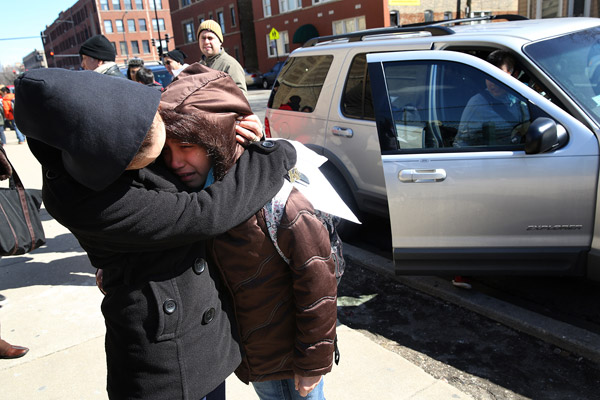
Photo: Nancy Stone/Chicago Tribune
Trumbull student Myra Paz reacts to the news that her school was selected for closure, March 21, 2013.
Earlier today, Alison Burke listened as the Chicago Public Schools Board of Education officially voted to shut down Lyman Trumbull Elementary, her family’s neighborhood school.
“It’s not a big surprise, obviously, but it’s still disappointing. It just feels like a slap in the face the way the lumped all the schools together and dismissed us all in one vote. They couldn’t even say the names of the schools we’ve been fighting for over the last year.”
As a parent and member of the local school council, Burke worked tirelessly to save the school that has educated Andersonville students at the northwest corner of Ashland and Foster for more than a hundred years—even though everyone kept telling her she was fighting a losing battle. “I just felt like I had to do everything I could. They just wanted us to quit,” Burke said earlier this month—“they” being the CPS administration and Mayor Emanuel, who promised school reform as part of his election campaign.
Of course, Trumbull’s not the only school that wanted off the list, but according to Burke and Trumbull administrators, it may be the only one that never should have been on it in the first place.
“We never asked for special treatment,” said Burke. “We just asked that CPS apply its own standard when determining which schools should stay open and which ones should be closed.”
CPS claimed that Trumbull was operating at 54 percent capacity, but it arrived at that figure using a one-size-fits-all formula to calculate utilization rates, regardless of how many special education students a school had. Trumbull has a large population of special needs students, and state law dictates that a classroom of special education children cannot exceed 7 students—or 14, depending on the level of disability and also whether or not a teacher’s aide is present. When you factor in the correct classroom capacities for each contingent of students, the overall utilization rate comes out to over 80 percent.
From the outset, CPS pledged not to close any schools with over 80 percent utilization, which makes the board’s decision all the more confusing and exasperating to Burke. “It’s so crazy,” she said. “They’ve admitted that they miscalculated our capacity—we have e-mails telling us, ‘Yeah, we made a mistake,’ yet here we are.”
Regardless, CPS not only kept Trumbull on the closing list, they “refused to tell us why,” Burke says. CPS ignored repeated e-mails, phone calls, even in-person appeals. Burke says CPS never responded to Trumbull’s formal written appeal, among those submitted by 19 schools.
“The process has been completely one-sided,” she said. “The so-called community feedback meetings were a joke. It was all just theatre.” For example, at one community feedback meeting conducted by CPS officials, Burke says she asked the Ravenswood-Ridge network chief Craig Benes to take questions from parents—and he refused. A week later, Benes visited Trumbull on report card pick-up day. Saying he only had one hour to meet with teachers and parents, Benes promised to answer questions after a presentation. According to Burke, he fielded one question, in which he admitted that LSC members at Chappell Elementary (one of three schools designated to receive Trumbull students) were instructed not to talk to Trumbull parents.
On another occasion, Benes attended a Trumbull forum, ostensibly to answer questions from concerned parents and teachers, but again the format imposed on the proceedings was needlessly obstructionist, Burke said. “We all had to write our questions down on yellow sticky notes, and they took all the sticky notes to Benes and—I kid you not—he answered only the ones he wanted to answer. They just sidestep anything that’s controversial.”


